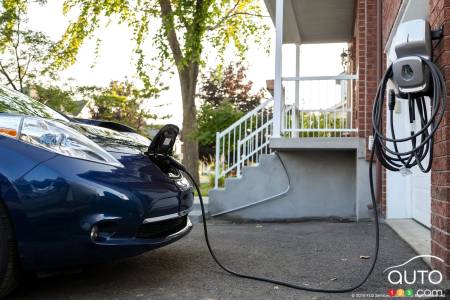Auto123 puts the Kia Niro EV to the long-term test. Today, part 15.
To be honest, there are so many articles on the Internet dealing with the same subject that I almost gave you half a dozen links to click, thus giving me the freedom to write about something else.
On the other hand, do you really have the time to go through all that reading? Whereas Auto123 pays me (a fortune, of course) to capture the essence of the subject in an 800-word text... which will double in this case because the subject is so dense. So here are 1001 tips summarized in a few, and spread over two parts of our long-term review.
Browse cars for sale available near you
An important bit of equipment
Before going over the factors that will influence the choice of your future charging station, we need to talk about the EV's best friend: the on-board charger.
The first job of the OBC (for, you guess it, “on-board charger”) is to welcome the alternating current coming from your home (and therefore from your charging station) and to direct it to the converter (see Part 13) of the EV, which will transform it into the direct current required by the battery. But it doesn't just do that.
It also protects your EV by supervising the flow of energy from the terminal. We’ve seen that the duration of a charge depends on the power of the terminal (Level 1, 2 or 3). But it also depends on the ability of the EC to convert the power of the electrical flow.
However, it is possible that the EC of your own EV has a different capacity than the power of the terminal. This is a common situation with public charging stations.
The good news is that the OBC can be adapted to all situations.
For example, if your EV's charging capacity via the OBC is 7.4 kW and you plug it into an 11.5 kW station, your charging will still not exceed 7.4 kW per hour, no matter ho much you swear at it. Recharging will take place but over a longer period of time, whereas it will be faster for the guy next to you whose EV is equipped with an 11.5 kW EC. Again, swearing won’t help.
Each EV model has a distinct OBC provided by the car manufacturer. Manufacturers choose the size of the OBC based on the size of the battery and (usually) try to minimize the impact of charging time by assuming that the owner will schedule a nightly charge. But the cost of the part itself remains a significant factor (and this part, before you ask me, is not changeable, even if you ask your dealer).
Can we ever hope for the same OBC for all EVs? And, while we're at it, more powerful? “Manufacturers like their independence and none of them like to be told what to do, as we can see in the battle over emission standards,” explains Yannick Lemelin, customer service coordinator at BEQ Technology. And so the role of the OBC is to adjust to the different charging stations, which at least distribute power using the standard J1772 gun (see Part 12 our long-term review of the Niro EV)."

What is your OBC?
On the ElectricRail.ca website, you will find the OBC rating of all EVs sold in Canada in 2021 (a list updated annually). The one for our Kia Niro EV, for example, is 7.2 kW (like the Hyundai Ioniq and the Kia Soul EV). The maximum I found: 11.5 kW for most Teslas.
This information allows for some instructive calculations...
We already know that 64 kWh / 7.2 kW = 8.8 hours to charge the Niro EV from 0 to 100 percent using the 240V of your future terminal.
And if you do 7.2 kW x 1000 / 240V, you get 30 amperes (30A), i.e. the maximum justifiable amperage of your terminal. In other words, there is no need to choose a charging station of more than 30A (a 30A station will give you about 300-350 km per night of charging). If it is less powerful, the charging time will be longer. If you don't drive much with your EV, that’s fine. But if you drive more than 200 km every day, it's better to choose a more powerful (faster) charging station, which will not damage your battery thanks to the OBC.
In this case, you might as well buy a higher amperage charging station and say to yourself that you are investing in the future since the technology is progressing so fast. "Planning for the future by choosing a more powerful bollard is an attractive possibility, but what will your budget say?" asks Yannick.
The more powerful the terminal, the more expensive it is to install, not to mention that your home electrical panel has a limit (often 200A). That's why, in order to respect the electrical code, any 240V device (such as the terminal) should not exceed 80% of the capacity of the equipment it is connected to. Thus, a 30A terminal requires a 40A circuit breaker.
“In short, you have to calculate everything,” says Yannick. “Heating, energy-consuming appliances, the heated pool, the spa... My advice: let professionals (read: like those at BEQ) guide you through a load calculation to find the right balance between your needs and your electrical capacity.”
With these wise words, we will see together in our next chapter the other criteria to consider when choosing the right terminal. Sharpen your pencil, there are about fifteen of them...
Specifications sheet of KIA Niro EV
See also: Kia Niro EV Long-Term Review, Part 1: The carmaker, the reviewer and the (young) enthusiast
See also: Kia Niro EV Long-Term Review, Part 2: Electric cars, a new idea with a long history
See also: Kia Niro EV Long-Term Review, Part 4: Getting a charge out of charging
See also: Kia Niro EV Long-Term Review, Part 5: Many kilometres, many questions
See also: Kia Niro EV Long-Term Review, Part 6: When the computer decides things, without consulting us
See also: Kia Niro EV Long-Term Review, Part 7: Off to Join the Electric Circuit
See also: Kia Niro EV Long-Term Review, Part 8: The Benediction
See also: Kia Niro EV Long-Term Review, Part 9: Beating the Cold
See also: Kia Niro EV Long-Term Review, Part 10: Let’s Talk Maintenance
See also: Kia Niro EV Long-Term Review, Part 11: Questions… and Answers
See also: Kia Niro EV Long-Term Review, Part 12: All About Nozzles
See also: Kia Niro EV Long-Term Review, Part 13: Station to Station
See also: Kia Niro EV Long-Term Review, Part 14: The Cost of Charging


